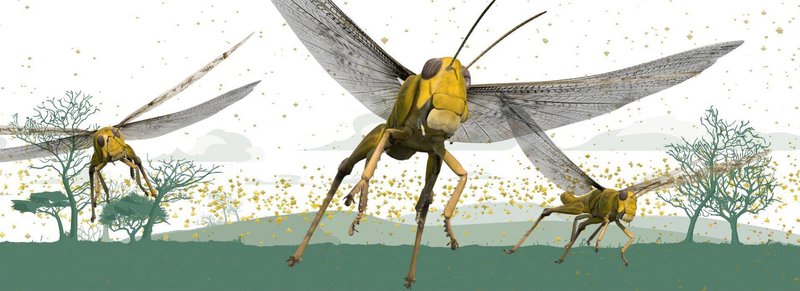
So, what does it mean for locusts to be pollinators? It involves a whole lot of buzz—quite literally! Think of locusts buzzing from flower to flower, much like bees, transferring pollen and helping plants reproduce. This might seem surprising given their notorious reputation, but understanding their multifaceted roles can reshape our perspective. Let me explain how pollination and other jobs done by locusts can be both fascinating and essential for our ecosystem.
Understanding the Role of Locusts in Ecological Systems
Locusts are part of the *Orthoptera* order, which also includes grasshoppers and crickets. When conditions are just right, some species of locusts can transform from solitary insects into swarming forms. This is typically triggered by factors like increased population density, environmental conditions, and food availability. But what’s intriguing is that during their lifecycle, locusts contribute to various ecological processes.
As they feed on vegetation, locusts can stimulate plant growth by pruning older or weaker plants. It’s almost like nature’s way of ensuring that only the healthiest plants thrive. This *pruning* encourages robust growth and can promote a healthier ecosystem overall. In other words, while they may be seen as pests, locusts have this dual nature, acting both as consumers and as contributors to plant health.
The Importance of Pollination
Pollination is crucial for many plants, especially those that produce fruits and seeds. While bees usually get most of the credit for this job, locusts can also play a significant role. When locusts feed on nectar, they move pollen from one flower to another, allowing plants to reproduce. Each visit to a flower helps facilitate this process, ensuring that plants can produce seeds for the next generation.
You might be wondering how effective locusts really are at this task. While they may not be the primary pollinators for many plants, they are certainly helpful allies to other pollinators. It’s like having a back-up band that supports the lead singer. Their contribution can enhance the overall efficiency of pollination in certain ecosystems.
Locusts and Soil Fertility
Another job locusts perform that may surprise you is their role in enhancing soil fertility. As they feed on plants, they break down organic matter, which eventually becomes part of the soil. This decomposition process releases nutrients back into the ground, making it richer for future plant growth.
Imagine a locust munching away at a plant—every bite they take breaks down elements of that plant. When they excrete waste, it adds vital nutrients like nitrogen back into the soil, promoting fertility. Over time, this can create more robust and diverse plant communities, which in return can support a variety of wildlife.
Locusts and their Role in Food Chains
Locusts occupy a unique position in food chains as well. They serve as a food source for many animals, including birds, reptiles, and various mammals. This relationship helps sustain populations of these predators and upholds balance within ecosystems. If there were no locusts, many of these predators would struggle to find enough food, which could lead to a ripple effect throughout the food web.
In simple terms, you can think of locusts as a stepping stone within a larger network. Their role ensures that energy is transferred from plants to higher trophic levels, ultimately sustaining various wildlife populations. The more diverse the food web, the healthier the ecosystem.
Challenges Faced by Locusts in Modern Ecosystems
Despite their important roles, locusts face several challenges today. Climate change is altering habitats, and agricultural practices can disrupt their natural lifecycle. For instance, the heavy use of pesticides not only targets pests but can also significantly reduce locust populations. This decline can have unforeseen consequences for pollination and soil health, highlighting the delicate balance of ecosystems.
Moreover, urbanization has led to habitat loss for many locust species. As cities expand, the natural areas that provide food and breeding ground for locusts decrease. Without these habitats, we risk losing not just the locusts themselves but also the beneficial roles they play in our environment.
Understanding Locust Swarms and Their Impact
When locusts swarm, the effects can be devastating. Swarms can cover vast areas and decimate crops in a short amount of time. This phenomenon often raises concerns about food security, particularly in regions dependent on agriculture. Yet, it’s important to recognize that these swarms are not happening in isolation; they are responses to environmental cues.
You might be surprised to learn that swarming behavior is a survival mechanism. When locust populations increase, their instincts kick in, leading them to gather in large groups. This behavior ensures that they can find food more effectively and migrate to new areas when resources become scarce. However, it poses challenges for farmers and necessitates careful management strategies.
In the grand scheme of things, locusts are much more than just agricultural pests. They play vital roles through pollination, enhancing soil fertility, and serving as food sources within the ecosystem. Understanding these roles can shift our viewpoint on these fascinating insects, revealing their contributions beyond destruction.
While it’s easy to focus on the negatives, it’s crucial to appreciate the delicate balance that locusts maintain in nature. As we face environmental challenges, recognizing and preserving the roles of all creatures, including locusts, can lead to healthier ecosystems and a more sustainable future. So next time you hear about locusts, remember: they’re busy little workers, doing more than just munching their way through crops!
